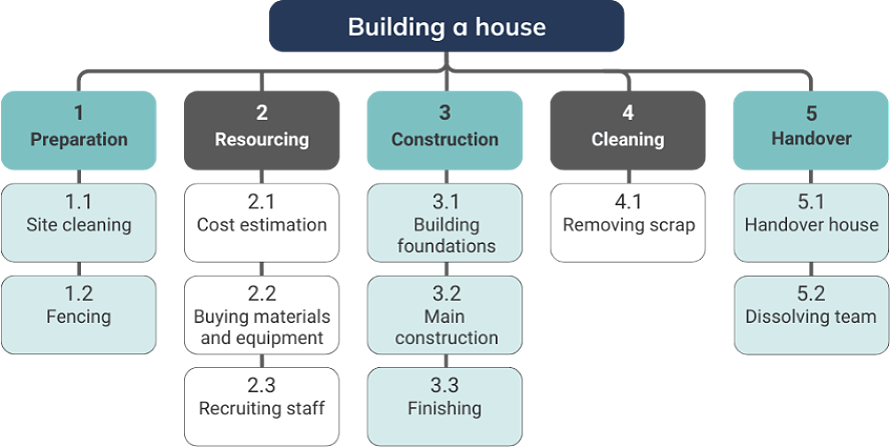
Introduction
In project management, the Work Breakdown Structure (WBS) stands as a cornerstone technique. A WBS is a hierarchical decomposition of a project into smaller, manageable components. This robust tool helps project managers organise and define the total scope of their projects. The importance of WBS in project management cannot be overstated.
A WBS provides a clear visual representation of project scope, facilitates accurate estimation of time, cost, and resources, and enhances communication among team members and stakeholders.
This article will explore the key aspects of WBS, including fundamental concepts and characteristics, benefits of implementation, and a step-by-step guide to creating an effective WBS. We’ll also examine various formats and tools, application in different project methodologies, and common challenges with their solutions. By the end, you’ll have a comprehensive understanding of how to leverage WBS for project success.
WBS fundamentals
To effectively implement a work breakdown structure, it’s crucial to grasp its key characteristics and essential components. This understanding will enable you to create a robust foundation for your project management efforts.

Key characteristics of WBS
- The 100% rule is a fundamental principle of WBS. It stipulates that the WBS must include all work required to complete the project, without omitting or duplicating any tasks. This ensures comprehensive coverage of the project scope.
- A hierarchical structure is another defining feature of WBS. It organises the project into increasingly detailed levels, starting with the overall project at the top and breaking down into smaller, more manageable components.
- WBS can be either deliverable-oriented or phase-based. A deliverable-oriented approach focuses on tangible outcomes, while a phase-based approach structures the project around distinct stages of completion. The choice depends on the nature of your project and organisational preferences.
Essential components of WBS
- Levels and decomposition form the backbone of a WBS. The top level represents the entire project, with each subsequent level providing more granular detail. This decomposition continues until you reach a level of detail appropriate for effective management.
- Work packages are the lowest level in a WBS. These are discrete units of work that can be assigned, scheduled, and tracked. Work packages should be small enough to be manageable but large enough to maintain efficiency.
- Control accounts are management points where scope, budget, actual cost, and schedule are integrated and compared to earned value for performance measurement. They serve as crucial checkpoints for project managers to monitor progress and make informed decisions
Understanding these fundamentals will equip you to create and utilise a WBS effectively, enhancing your project management capabilities.
Benefits of a WBS
Incorporating a work breakdown structure into your project management approach yields numerous advantages that can significantly enhance project outcomes.
- Improved project planning and organisation: By breaking down complex projects into smaller, manageable components, project managers can develop more accurate timelines and identify potential bottlenecks early. This granular view allows for more precise scheduling and resource allocation, leading to smoother project execution.
- Enhanced communication and clarity: The visual representation of project components facilitates a shared understanding of project scope and objectives. This clarity reduces misunderstandings and ensures all parties are aligned on project deliverables and expectations.
- Efficient resource allocation and budgeting: The detailed breakdown of tasks in a WBS enables project managers to estimate resource requirements more accurately. This precision in resource planning helps prevent overallocation or underutilisation of personnel and materials, ultimately leading to more cost-effective project execution.
- Better project tracking and control: The hierarchical structure allows managers to monitor progress at various levels of detail. By comparing actual progress against the WBS, project leaders can quickly identify deviations from the plan and implement corrective actions promptly. This proactive approach to project management increases the likelihood of successful project completion within established constraints.
Creating an effective WBS
Developing a robust work breakdown structure is crucial for project success. This section provides a step-by-step guide and best practices to help you
create an effective WBS.
Five steps guide to developing a WBS
- Defining project scope and objectives: Clearly articulating your project’s scope and objectives. This essential step ensures that your WBS aligns with the overall project goals. Collaborate with stakeholders to establish a comprehensive project charter that outlines key deliverables, constraints, and success criteria.
- Identifying major deliverables: Identify the high-level deliverables that must be produced to achieve project objectives. These form the first level of your WBS hierarchy. Consider both tangible and intangible outcomes that contribute to project completion.
- Breaking down deliverables into manageable tasks: Systematically decompose each major deliverable into smaller, more manageable components. Continue this process until you reach a level of detail that allows for accurate estimation and effective task assignment. Remember to apply the 100% rule at each level of decomposition.
- Assigning responsibilities and resources: For each work package, designate responsible individuals or teams. Allocate necessary resources, considering both human and material requirements. This step enhances accountability and facilitates efficient resource management throughout the project lifecycle.
Best practices for WBS creation
- Maintaining proper level of detail: Strike a balance between too much and too little detail in your WBS. Excessive granularity can lead to micromanagement, while insufficient detail may result in overlooked tasks. Aim for a level of detail that allows for effective planning and control without becoming unwieldy.
- Ensuring mutual exclusivity of tasks: Each element in your WBS should represent a unique piece of work. Avoid overlapping or duplicating tasks to prevent confusion and double-counting of effort. Clear boundaries between work packages promote accurate resource allocation and progress tracking.
- Applying the 8/80 rule for work packages: The 8/80 rule suggests that work packages should require no less than 8 hours and no more than 80 hours of effort. This guideline helps maintain a manageable level of detail and facilitates accurate estimation. Adjust this rule as needed to suit your project’s specific requirements and reporting cycles.
By following these steps and best practices, you can create a comprehensive and effective WBS that serves as a solid foundation for your project management efforts.
WBS formats and tools
- Effective implementation of a work breakdown structure relies on choosing the right format and tools. This section explores common WBS formats, software options, and integration with other project management tools.
Common WBS formats
- Tree diagram: This hierarchical representation visually illustrates the project’s decomposition. It starts with the project at the top and branches out into increasingly detailed levels. Tree diagrams offer a clear overview of the project structure and relationships between elements.
- Outline or list view: This format presents the WBS as a numbered or bulleted list. Each level of indentation represents a new level in the hierarchy. Outline views are simple to create and can be easily converted to other formats.
- Tabular format: This approach organises WBS elements into columns and rows. It’s particularly useful for including additional information such as task owners, durations, or costs alongside the WBS structure.
Software tools for creating and managing WBS
- Dedicated WBS software: Specialised tools like WBS Schedule Pro offer robust features for creating and managing work breakdown structures. These applications often provide advanced visualisation and analysis capabilities.
- Project management platforms: Many comprehensive project management solutions, such as Microsoft Project or Wrike, include WBS functionality. These platforms integrate WBS with other project management features for a more holistic approach.
Integrating WBS with other project management tools
- Gantt charts: WBS elements can be directly translated into Gantt chart tasks. This integration allows for visual representation of task dependencies and timelines.
- Project schedules: The WBS serves as the foundation for detailed project schedules. Each work package in the WBS can be expanded into specific activities with durations and resource assignments.
By selecting the appropriate format and tools, project managers can maximise the benefits of WBS implementation and enhance overall project performance.
Common WBS challenges and solutions
While work breakdown structures offer numerous benefits, their implementation can present challenges. Recognising these obstacles and applying effective solutions can enhance your WBS implementation.
Scope creep occurs when project boundaries expand uncontrollably. To mitigate this, clearly define project scope in the initial WBS development and implement a rigorous change control process. Regularly reviewing and updating the WBS to reflect approved changes helps maintain alignment with project objectives.
Striking the right balance between detail and manageability is crucial. Too much detail can lead to micromanagement, while too little can result in oversight. To achieve balance, apply the 80/20 rule for work packages and use progressive elaboration, adding detail as the project evolves. Regularly assess the WBS’s effectiveness and adjust as needed to maintain optimal utility.
Team buy-in is essential for successful WBS implementation. Involve team members in the WBS creation process and clearly communicate the benefits to all stakeholders. Providing training and support for WBS usage encourages adoption. Celebrating successes and improvements resulting from WBS implementation reinforces its value to the team.
By addressing these common challenges, you can maximise the effectiveness of your WBS and enhance overall project management outcomes.
Case study
To illustrate the practical application of work breakdown structures, let’s examine a real-world project. A multinational technology company undertook a complex software development initiative to create a new customer relationship management (CRM) system.
The project team implemented a comprehensive WBS, breaking down the CRM development into major components such as database design, user interface, integration modules, and testing phases. This structured approach allowed for precise resource allocation and scheduling. The WBS significantly contributed to the project’s success by providing a clear roadmap for all stakeholders. It facilitated effective communication between development teams and enabled accurate progress tracking. As a result, the project was completed on time and within budget.
Key lessons learned from this case study include the importance of stakeholder involvement in WBS creation and the value of regular WBS reviews. The team found that maintaining flexibility in the lower levels of the WBS allowed for Agile responses to changing requirements. Best practices derived from this experience include engaging cross-functional teams in WBS development, regularly updating the WBS to reflect project realities, and using the WBS as a central communication tool throughout the project lifecycle.
This case study demonstrates how a well-implemented WBS can drive project success in complex initiatives.
Conclusion
The WBS stands as a fundamental tool in project management. We’ve explored its key characteristics, benefits, creation process, and application across various methodologies. WBS provides a structured approach to project planning, enhancing organisation, communication, and control. Its adaptability allows for implementation in Traditional, Agile, and Hybrid environments.
By addressing common challenges and learning from real-world successes, project managers can leverage WBS to significantly improve project outcomes. As you move forward with your projects, consider implementing a WBS to bring clarity, efficiency, and precision to your management approach. The benefits of WBS are clear, and its potential to drive project success is substantial.
FAQs
What is the difference between a WBS and a project schedule?
A WBS breaks down project scope into deliverables, while a project schedule adds timelines and dependencies to these components.
How detailed should a WBS be?
A WBS should be detailed enough to allow for accurate estimation and assignment, typically following the 8/80 rule for work packages.
Can WBS be used for small projects?
Yes, WBS can be scaled to fit projects of any size, providing structure and clarity even for smaller initiatives.
How often should a WBS be updated during a project?
A WBS should be reviewed and updated regularly, particularly at key milestones or when significant changes occur in project scope.
What is the relationship between WBS and risk management?
WBS supports risk management by providing a structured framework for identifying potential risks associated with specific project components or deliverables.








